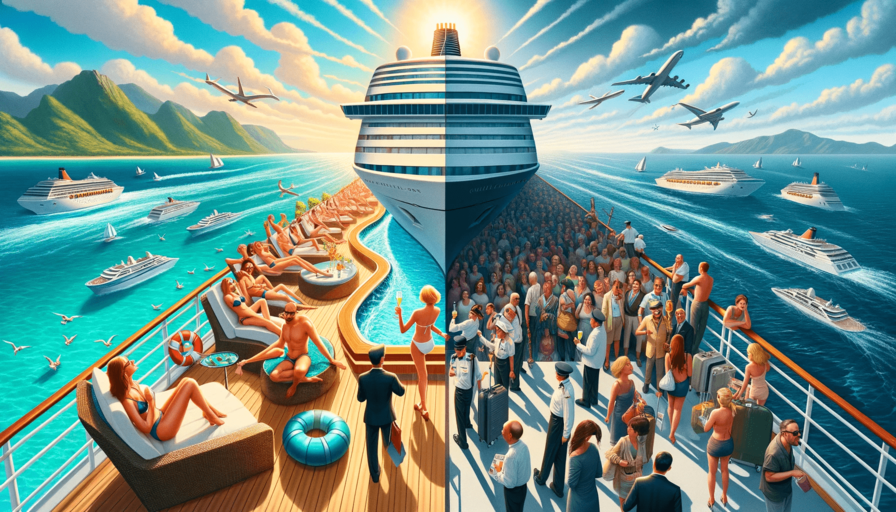There’s a newer cruise line that caters to adults only, boasting they take you to more unique ports than many other lines. No kids and better places? Sign us up. So, we did… and we (somewhat) wished we didn’t.
It all started with a “need” to go to the south of France, Monaco, Mallorca, and Ibiza with a group of total strangers around our age. We chose our sail date, our room, downloaded the app like they asked, and followed them on Instagram (which we stalked religiously as though we were about to join some elite club). Easy! In addition, each week before our sail date, they’d also send us another “hype” email to keep our enthusiasm at an all-time high – food delivery to our room? A Romance package with champagne? Free spa treatments? Sign us up!
By the time the date came to sail, we were so hyped that we could barely contain ourselves… until it was time to check in. Sadly, their incredible customer journey started to sink right at that moment, having been completely submerged by the time our cruise was over.
So, how (and when) did their customer journey and marketing fail that hard? The minute actual people were involved. Below are some “lessons learned” from our experience that can be useful in developing and maintaining your own customer journeys and marketing strategies.
Lesson 1: An Automated Journey and Great Sales Marketing = “Smooth Sailing”
This cruise line is GREAT at automated customer journeys and sales marketing. Their well-timed emails, splashy graphics, great social media presence, and cheeky descriptions would bring nearly anyone “on board” with purchasing their services. Afterall, it’s the first hook for the customer that causes them to “bite”, and this company has always done that well.
Well-timed emails reminded us to complete tasks on our app, sent countdown clocks to excite us, offered us well-priced add-ons, enticed us with unique onboard dining options that virtually no other cruise line really offered, and gave us so many different excursion options that seemed like dream day trips. To myself and my husband, it was a dream to finally have a cruise line that “spoke our language”, and we couldn’t wait to embark on this journey with them.
Tip: While not every organization can be as bold and “cheeky” as this cruise line, new ways of catching a prospect’s eye tend to work better over the tried-and-true. With sensory and informational overload constantly at a peak, our minds actively look for new ways to be stimulated.
Lesson 2: You Never Get a Second Chance to Make a First Impression – How This Cruise Line Sprung a “Minor Leak”
The day arrived to embark on the cruise. We were in Barcelona to begin our journey and we had paid a bit extra to get on the ship first. As our taxi arrived at the port, we saw a long line of hundreds of people – many looking unhappy. We figured that, that was probably the regular line, so we handed our bags to the porter, did the initial check-in, and are then told to go to the back of THAT line. There was no explanation and no apologies. We could tell the staff knew about as much as we did.
About 1 ½ hours later, we learned that they were delayed on letting people in, and what we paid for, put us in a shorter check-in line once inside. Sadly, many of us that paid for this “shorter” line were upset at how this was done, with many asking the check-in staff, “what did we pay for”? Now, as a customer experience professional (and as someone who adores well-orchestrated logistics), that didn’t sit right with me (my husband was just happy to be there). It caused me, as well as many others, to become a skeptic on what the rest of the cruise journey would be like, simply because that was our first real interaction, and it wasn’t done well.
Tip: Make sure the initial journey a customer goes through is impactful, memorable, and easy-to-follow. Train your staff on it repeatedly, if necessary. It’s imperative that you set the expectation for the customer before they set it for you.
Lesson 3: The Connection from EX to CX Is Crucial – How The Cruise Line’s Distress Signal Was Set Off
With my “CX glasses” now firmly on for the rest of the trip, I saw and experienced staff interactions that for myself, as well as many other passengers, were way below our set expectations. This was due to (what we believe was) low pay in their contracts, tips already being included in the fare, and the overall treatment/training of the staff.
Know Your Customer, Hire Accordingly
We believe the average age of the staff was around 25, with management hovering around 30, with the average age of the cruiser being of the “empty nester” years. While we later learned the reason for this (see the Lesson 4 on Marketing), us cruisers often discussed (with each other) how there wasn’t a single crew member around our age that could relate to us and our expectations, and that potentially, this cruise line was meant for a much younger demographic. In addition, we believed that Virgin was hiring fresh, attractive faces that were willing to take the job, and not necessarily because they had a deep passion for customer service – something that should be required for customer-facing jobs.
Tip: Building your customer profile is key to good hires. When you understand your customer, you understand the kinds of talent that need to be hired into roles.
Your Employee Culture Is Only as Good as the Training/Pay They Receive
One evening, we decided to attend a music trivia game. The cruise director was in charge of hosting it. All of 26 years old (we know because he told us), he started with standup “comedy” that can only be described as a tongue-in-cheek way of “airing his grievances” about working for the cruise line. We learned everything about his employment contract, to his pay, to how the
cruise line couldn’t afford to pay for the additional ships they ordered because they weren’t actually making money (cue the screeching record scratch). What? Everyone looked at each other to confirm others heard the same. Sadly, in this post-COVID era, this is an all-too-common issue with many organizations, and it comes down to the budget for the right talent and the training they receive. Had this cruise line not cut corners on contracts and pay, in favor of attractive cruising prices, they may have landed better talent. In addition, as I later learned, the training program is standard corporate training with no deviation for how to work for a cruise line, which is a much different customer service focus.
Tip: How your employees represent your organization, during and after their tenure, is how your organization will always be perceived. At the very least, training and re-training is crucial to the success of that perception.
Empower Your Employees
We had just come back from a rather brutal excursion through the south of France and Monaco. This isn’t sarcasm. Those that paid for a “Create Your Own French Itinerary”, assumed it would be just that – the ability to wander, at leisure, in both places. Instead, it was a long bus ride, 30 minutes, another bus ride, 60 minutes, and so forth. By the time we got back to the ship, we agreed that we would cancel the rest of the excursions and actually create our own itineraries from there on out.
I headed down to the service desk to explain the situation and get the rest canceled. We stood with the woman for nearly 45 minutes before she explained that a manager would have to cancel on her behalf and that the manager would text me on the app. She went on to say that service reps do not have the authority to do this. Thankfully, it was a swift cancelation after that, but it left me wondering just how many people have been through unsuccessful and time-consuming interactions with these reps and what kind of impression that left on them. Why wouldn’t these employees be empowered to make these kinds of decisions? The answer: If training was done properly, answers arrive much quicker. In this case, had the rep known the limitations of her role, she’d have been able to provide a faster solution by having us contact the manager directly to get our request resolved.
Tip: A customer support journey is the second most important journey you can create and implement. Time is valuable for everyone!
Lesson 4: The Brand is Only as Consistent as its Marketing – This Cruise Line Needs a Lifeboat
We are the second to the last night into the cruise, really unsure of what we have experienced. It’s “red night” where everyone dresses in red and dances the night away until nearly 3am (we danced for 20 minutes at 11pm and went to bed). We kicked off our evening by heading to our reservation at a rather lively Japanese Steakhouse and were seated with four women from the UK. We all quickly shared our experiences we had had so far, and the subject of marketing came up. They told us that in the UK, this cruise line marketed the cruise as an 18-and-older cruise ship with unlimited partying and drinking – something that made them hesitant to book.
We told them our marketing was based around being kid-free, hence all the American empty-nesters on board that seemed confused as to why so many young people were there.
In addition to this, the topic of the aforementioned excursions came up. We agreed that whoever wrote the descriptions for these was (is) an incredible writer but the reality of what you got was far below expectations. With that big of an expectation vs. reality disparity, it’s no surprise why many people are hesitant to book another cruise with this line in the future.
Tip: When you know your customer profile, it’s easy to market properly across all countries you identify as having potential customers in, especially in a situation where customers will interact with each other. Never should a message deviate that far from reality.
What This Voyage Taught Us About the Intersection of CX, EX, and Marketing
It’s fairly simple – if your employees aren’t happy, your customers will feel it. If your employees aren’t trained properly, your customers will feel it. If you do not have your CX, EX, and marketing journeys mapped, integrated, and implemented correctly, then your customers will be tired of waiting for their expectations to be met and instead, will have bad reviews on their mind.
Nichole Hinton is an award-winning speaker, mentor and practitioner of customer experience and operations. Having been in tech for over 25 years, Nichole has had the honor and privilege of working with some of the most notable leaders in the world to solve challenges in the areas of sales, marketing, and customer experience & operations. Over her tenure, her solutions and programs have resulted in nearly $500mm in additional identified and realized revenue, an average 92% renewal rate, an average 95% upgrade rate for SaaS-based companies, and the curation of Fortune 500 Executive Customer Advisory Boards. She currently owns and operates N&M Consulting – a consulting firm focused on marketing and CX.

